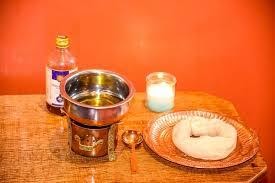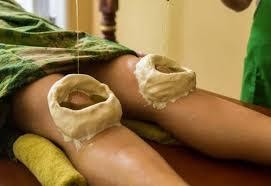
ROLE OF JAANU BASTI IN MANAGEMENT OF KNEE PAIN
- July 6, 2021
- Posted by Dr. Vaidya Karanvir Singh
- 0 Comment(s)
Knee pain is a common knee problem that affects people of all ages. Knee pain may be the result of an injury, such as a ruptured ligament or torn cartilage. Many medical conditions like arthritis, gout and many kind of infections — also lead to knee pain. It is a condition which is related to our musculoskeletal system.
Table of Contents
SYMPTOMS
The location and severity of knee pain may vary, depending on the cause of the problem and structure involved people may notice following symptoms –
- Difficulty in walking
- Swelling and stiffness around knee joint
- Inability to extend the knee
- Unable to bend the knee
CAUSES FOR KNEE PAIN
Knee pain can be due to any kind of injury to the knee joint , any kind of medical condition and other factors like overweight, age are also responsible for this.
Diagnosis of knee pain –
Diagnosis of cause of knee pain is made by
– Examination of patient
– Imaging techniques like X-ray , CT – scan , MRI are commonly used and very helpful to diagnose the condition
– Blood investigations – In any kind of medical condition like RA , gouty arthritis these are used to confirm the diagnose.
AYURVEDIC APPROACH FOR KNEE PAIN MANAGEMENT
Knee pain in ayurveda is described under vataj disorder which means it mainly occur due to the vitiation of vata dosha. Diseases described are Sandhigat vat ( mainly due to vata dosha), Aamvat ( due to undigested food i.e aama and vata dosha ), Raktgat vat ( due to vitiation of rakta and vata dosha ).
Treatment of knee pain in ayurveda is very specific and shown to be very effective . Acc. to the cause treatment is done by panchakarma therapies with combination of medicines .
JAANU BASTI IN KNEE PAIN
JAANU BASTI
Jaanu basti is the procedure that is widely used for the treatment of knee pain. janu basti word has two terms
’Janu’ means knee joint
‘Basti’ means to retain or hold
Janu Basti is a procedure in which medicated oil is poured and poured around the knee joint and retained for fixed period of time .This will help to reduce the pain, stiffness, and discomfort of the knee. Degeneration of bones , inflammation, and injury of knee joint are some of the main causes that leads to knee pain, and Janu Basti can help support these.
COMMON USED OIL IN JAANU BASTI
- Ksheerbaladi tailam
- Balashwgandhadi tailam
- Mahanarayan tailam
- Dhanwantram tailam
- Sehcharadi tailam
- Kottamchukadi tail
- Dashmool tail
- Tila tail
PROCEDURE OF JANU BASTI
Janu basti is done by below given method
Purvakarma ( pre treatment procedure )
Preparation of patient
Examination of the patient is done thoroughly to know the prakriti , vikriti of the patient and disease. And then the medicated oil used for the procedure should be decided accordingly.
Preparation for the treatment
Material needed for the treatment should be collected before the treatment. This include oil used for janu basti , oil used for abhyangam ( if required ) , Flour of black gram , water , sterile cloth. cotton, tissue.
Pradhana karma ( Treatment proper )
Positioning of the patient
Patient is positioned and made to lie on the comfortable bed in supine position. Then a ring or compartment should be made around the knee joint from bolus prepared from the flour. The junction is sealed properly with wet flour. Janu basti should be started after confirming that there is no leakage of oil.
Procedure of oil pooling
Required quantity of oil is taken and heated . Vessel containing oil should kept in a bowl containing warm water to prevent cooling of oil. Oil is poured into the ring in a proper way.
Temperature of the oil should be kept uniform throughout the procedure . And for this, oil from the pool is removed at regular intervals and replaced by warm oil.
Paschat karma ( post treatment procedure )
Removal of oil and flour
After the end of the procedure the oil should be removed slowly from the ring and stored in the container . Same oil can be used on the next day. Flour is also removed .
Abhyangam
After procedure, a light massage is given locally for 5- 10 mints . While massaging more pressure is not to be apply.
Swedan
Nadi swedan for 5-10 minutes is given locally.
After the completion of the treatment residual oil should be cleansed with tissue , cotton or cloth dipped in warm water.
Duration of the procedure
Janu basti is commonly done for 7-14days. Procedure involves time duration of 30-45 minutes.
Benefits Of Janu Basti
Janu Basti is an effective and most commonly used therapy for the knee pain . The medicated oil used in the therapy effectively soothes pain, stiffness, and inflammation in the joints.
Pain management
The warm oil poured over the knee joints, help them relax and relieves joint pain.
Helps to reduce stiffness
Janu Basti increases the flow of oxygen and nutrient-rich blood, and therefore relieves stiffness.
Improves mobility and flexibility
Lubrication of the knee joint is done with Janu Basti which help to increase mobility of the knee joints
Lowers inflammation
The medicated oils that are used in janu basti have anti-inflammatory properties that help to reduce inflammation and pain.
Strengthens knee joints
Janu Basti boosts blood flow strengthening the muscles, bones, and joints of the knee.
Other panchakarma procedures which are done in knee pain are
– Patra pottli pind sweda
– Shashti shali swead
– lepa around knee joint
– Matra basti
Janu basti is the best ayurvedic procedure that is used in all type acute and chronic conditions of knee pain. Janu basti forms an important part of knee care , a part of ‘prevention is better than cure ‘ mantra.

Dr. Vaidya Karanvir Singh is the younger Vaidya in Chandigarh Ayurved & Panchakarma Centre. He is the fourth generation in his family who is practicing as a general consultant in Ayurved & Panchakarma treatment at Chandigarh. In his practice, he had treated more than 1 Lakh Plus patients worldwide.




